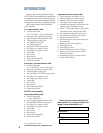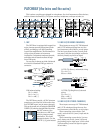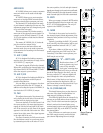
12
CHANNEL STRIP FEATURES
18. LOW CUT
The LOW CUT circuit, often referred to as a
high-pass filter, cuts the bass frequencies
below 75 Hz at a rate of 18 dB per octave.
We recommend that you use LOW CUT on
every microphone application except kick
drum, bass guitar, or bass-heavy synth patches.
LOW CUT can also help reduce the possibility
of feedback in live situations and it helps to
conserve amplifier power.
2-BAND CHANNEL EQ
The DFX Mixers use “shelving” equalization.
This boosts or cuts all frequencies past a speci-
fied frequency. For example, turning the
LOW EQ (20) knob clockwise will boost the
bass frequencies at 80 Hz and below.
Although you can bring sound to life with
proper EQ, you can also mess things up. If you
max the EQs on every channel, you’ll get mix
mush, not to mention driving your mix levels
near or beyond clipping. So equalize subtly;
use cut as well as boost.
Adjusting the channel EQ will affect your
main mix and the AUX 2/EFX (8) output, but
not the AUX 1/MON (7) output.
19. HI EQ
This control provides up to
15 dB of boost, or 15 dB of cut
at 12 kHz and above. There is
no boost or cut at the center
detent position.
Use this wisely to add sizzle to cymbals or
an overall sense of transparency or edge to
keyboards, vocals, guitar, and bacon frying.
Turn it down a little to reduce sibilance or
hide tape hiss.
20. LOW EQ
This control provides up
to 15 dB of boost, or 15 dB of
cut at 80 Hz and below.
There is no boost or cut at
the center detent position.
Frequencies of 80 Hz and
below represents the punch in bass drums,
bass guitar, fat synth patches, and
high-testosterone male singers.
While adding boost, also engaging the
LOW CUT (18) switch can create an audible
low frequency boost without boosting stage
rumble, mic-handling clunks, and breath pops.
OVERVIEW
The channel strips are independent of each
other, and allow you to adjust, tweak and other-
wise beautify the sound coming from your
different microphones, guitars and other in-
struments. The Faders and Pans let you adjust
how much of each channel is sent to the main
mix. The Auxes let you adjust how much of
each channel goes to your stage monitors or
out to external or internal effects.
The channel strips come in two flavors:
Mono and Stereo. In addition, the DFX•12 has
two line-level-only stereo channels.
16. GAIN
If you haven’t already, please read “SET
THE LEVELS” on page 5.
The GAIN control adjusts the input sensitiv-
ity of the mic and line inputs on each channel.
This allows signals from the outside world to be
adjusted to optimal internal operating levels.
Through the mono channel MIC (XLR) in-
puts, there is 50 dB of gain fully up. For stereo
channel MIC inputs, this is +40 dB.
Through the mono channel LINE IN (TRS)
inputs, there is 20 dB of attenuation fully down
and +30 dB of gain fully up, with a “U” (unity
gain) mark halfway up. The stereo channel
LINE INs have a maximum gain of +20 dB.
Having 20 dB of line-level attenuation can
be very handy when you are injecting a signal
that is very hot, or when you want to add a lot
of EQ boost, or both. Without this “pad,” it
would be very difficult to control the line sig-
nal and might lead to channel clipping.
17. LEVEL SET LED
This LED (Light Emitting Dohickey) lets
you know that the signals going into the mixer
are adjusted to the correct level, not too strong
to cause distortion and not too weak to be lost
in noise.
After you connect a microphone or line-
level component to the mixer, do a sound test
and adjust the GAIN (16) control until this
handy LED flickers just occasionally. If it is
glowing constantly, turn the GAIN down. If the
LED is doing almost nothing, turn it up.
Mono Channel
20
Hz
100
Hz
1k
Hz
10k
Hz
20k
Hz
–15
–10
–5
0
+5
+10
+15
LO
W
20
Hz
100
Hz
1k
Hz
10k
Hz
20k
Hz
–15
–10
–5
0
+5
+10
+15
HI
dB
30
20
10
OO
40
50
5
5
U
60
10
1
PAN
R
L
2
EFX
AUX
1
MON
HI
12k
EQ
LOW
80Hz
GAIN
1
75 Hz
LOW CUT
LEVEL
SET
U
-
20dB
+
30dB
+50
MIC
MIN
U
+15-15
U
+15-15
U
OO
+6
OO
+6
U
OL
MUTE


















